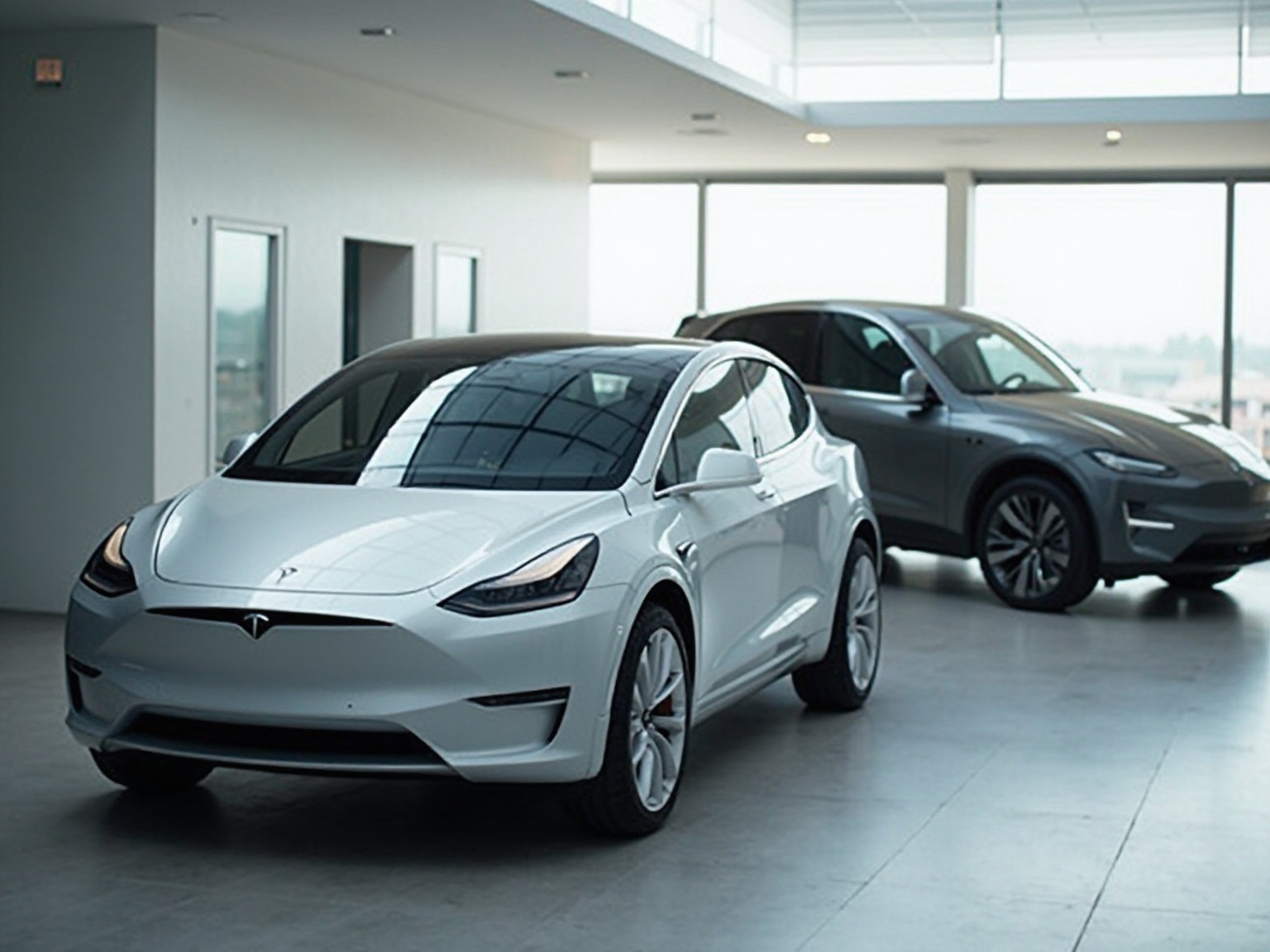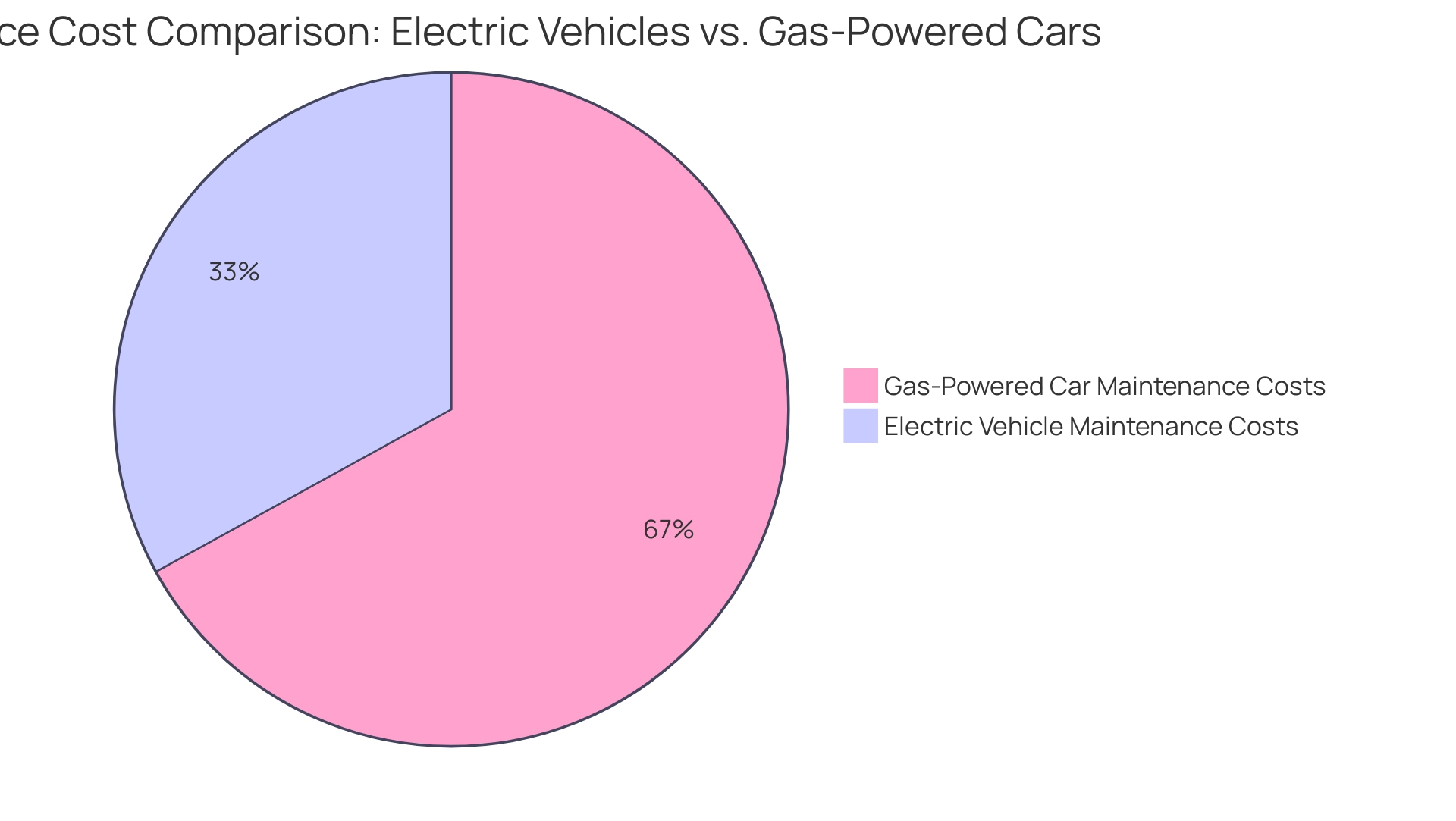Overview
We understand that managing energy bills can be a significant concern for many homeowners. In exploring the cost per mile of operating a Tesla compared to gasoline vehicles, we find that a Tesla typically costs about $0.04 per mile, which is significantly lower than the $0.13 per mile average for gas cars. This substantial difference not only highlights the long-term financial benefits of owning a Tesla but also opens the door to a more sustainable lifestyle.
When combined with solar power for charging, the potential to further reduce expenses becomes even more promising, aligning perfectly with sustainable energy practices. Together, we can embark on a journey towards energy independence, ensuring that your choices contribute to a healthier planet.
Let’s work towards a future where your energy habits reflect your values, and feel free to reach out for support and guidance on this rewarding path.
Introduction
In today’s rapidly changing automotive landscape, we understand that choosing between electric and gasoline vehicles is a significant decision—one that weighs heavily not just for environmental reasons, but also for your financial well-being.
As electric vehicles, especially those from Tesla, continue to gain popularity, it’s crucial to grasp the cost per mile, maintenance expenses, and charging options available to you. This analysis explores the various facets of owning a Tesla compared to a traditional gas-powered car, illustrating the substantial long-term savings and benefits that accompany electric vehicle ownership.
With lower operational costs and the integration of renewable energy solutions, the financial advantages of driving a Tesla are compelling. Together, we can make informed choices that not only reduce our carbon footprint but also lead to significant savings for eco-conscious consumers like you.
Comparing Cost Per Mile: Tesla vs. Gas Vehicles
When considering the cost per mile of operating a Tesla compared to a gasoline vehicle, it’s natural to have concerns about expenses. The typical cost to operate a 2025 Model 3 is approximately $0.04 per mile, a striking contrast to the average of $0.13 per mile for gasoline automobiles. This significant difference underscores the potential savings for vehicle owners, especially for those who drive frequently, when evaluating the Tesla cost per mile against gas options.
The proposed price for the 2025 Model 3 Performance is $47,490, providing context for the overall investment in an electric car. We understand that electricity expenses can vary based on regional pricing; however, they generally remain more affordable than gasoline prices. This highlights the Tesla cost per mile as a financially wise choice over time. Furthermore, as more homeowners adopt solar solutions, particularly in California, there’s an opportunity to further reduce driving expenses by utilizing solar power to charge their Teslas. This not only enhances overall savings but also aligns with sustainable practices, allowing drivers to harness clean resources for their transportation needs.
In real-world scenarios, electric vehicle owners have reported substantial cost savings compared to traditional gasoline vehicle drivers. This is particularly evident when examining the Tesla cost per mile versus gas, along with the long-term advantages of reduced fuel expenses and the potential for solar charging. Government programs promoting solar energy adoption can also provide financial incentives, making the transition to solar-powered charging even more appealing. As Jonathan Elfalan, Director of Vehicle Testing, mentioned, ‘Last year, the company provided the Model 3 with a significant update that featured revised styling, a quieter and higher-quality cabin, and a smoother ride quality.’ This highlights the ongoing enhancements in the company’s offerings, which may influence cost considerations for potential buyers.
Additionally, the case study titled ‘Model 3 Wildcard Features’ illustrates that despite some common concerns among owners, the Model 3 Long Range remains a top recommendation for its extended range, higher charging rate, and overall performance. As electric vehicles gain traction, the financial benefits of owning a vehicle from the company, especially when combined with solar power options, become increasingly compelling. Many reviewers describe the Model 3 as life-changing, emphasizing its instant torque, minimalist design, and exceptional service interactions, further underscoring the overall value and satisfaction of ownership.
Moreover, exploring options for solar panel cleaning services and efficient battery storage can significantly enhance the solar energy experience for homeowners. Together, we can ensure you maximize your investment in renewable energy, paving the way for a more sustainable future.
Understanding Tesla Charging Costs: Home vs. Public Charging
We understand that charging an electric vehicle at home can be a concern for many homeowners, with costs typically ranging from $10.98 to $18.00 for a complete charge, influenced by local electricity rates. In contrast, public charging stations often impose significantly higher fees, with costs ranging from $0.20 to $0.60 per kWh. Specifically, charging at a Tesla Supercharger can set users back between $0.36 and $0.55 per kWh, which can accumulate quickly for those who frequently rely on public charging.
However, there is a brighter option. Homeowners who invest in solar panel installations can substantially reduce these expenses by utilizing solar power for vehicle charging. Imagine being able to reduce your charging expenses to as little as 5 cents per kilowatt-hour, resulting in a total charging amount of only $3.78 to $6.07 for a full charge. This not only makes home charging more convenient but also significantly more economical compared to public charging options.
Moreover, a solar system can produce between 6,130 and 10,500 kWh of electricity per year, providing ample energy for both home use and EV charging. The economic advantages of home solar charging are further illustrated in case studies, such as the one titled ‘Benefits of Home Solar Charging for Electric Vehicles,’ which reveals that homeowners can achieve substantial savings on their charging costs. As Jamie Smith, a content writer and researcher at SolarReviews, notes, “By switching to an electric vehicle, you can save over $150 each month or over $1,800 annually!”
Additionally, the Tesla Home Charger price typically ranges from $500 to $700, depending on the model and installation requirements, making it a worthwhile investment for homeowners looking to maximize their savings.
As the trend towards electric transportation continues to grow, it’s common to feel overwhelmed when evaluating charging options, particularly the Tesla cost per mile versus gas. By utilizing solar power, homeowners can improve their autonomy while benefiting from reduced charging expenses, making the switch to electric transportation even more attractive. Furthermore, government programs aimed at promoting sustainable energy practices can provide additional financial incentives for homeowners adopting solar solutions.
Together, we can explore how the integration of solar-powered heating solutions further supports the economic and environmental benefits for California homeowners, aligning with these initiatives.
Gas Prices vs. Electric Charging: A Cost Analysis
As we look ahead to March 2025, the average gas price in the U.S. is projected to be around $3.22 per gallon. This figure resonates with the gasoline price of 374.1 cents per gallon recorded on October 30, 2023. It’s common to feel concerned about these rising costs, especially when comparing the Tesla cost per mile versus gas. For instance, to fully charge an electric vehicle like the Tesla Model Y, the expense is approximately $13.20, translating to about $0.04 per mile.
This significant difference highlights that while electric transportation may come with a higher initial investment, the ongoing fuel costs are considerably lower than those associated with gasoline-powered vehicles. Furthermore, the inherent volatility of gas prices suggests that owners of electric vehicles benefit from more predictable and stable charging expenses, enhancing the overall financial appeal of electric modes of transport.
In practical scenarios, the financial advantages of electric transportation become even clearer. The Tesla cost per mile versus gas indicates that the cost per mile for gasoline-powered vehicles can exceed $0.15, depending on fuel efficiency. This comparison underscores the long-term savings potential for electric car owners, who not only reduce their fuel expenses but also contribute to a more sustainable energy future.
As Shuting Pomerleau, Director of Energy and Environmental Policy, noted, the energy-related executive orders from President Trump are unlikely to have immediate impacts on U.S. oil and gas production or prices. This indicates a continued reliance on fossil fuels that could affect future gasoline costs. It’s understandable to feel uncertain about these developments, but expert opinions reinforce that the shift to electric transportation is not just an environmental choice; it’s a financially wise decision as well.
Companies like Powercore Electric Inc., which focuses on solar solutions, including solar panels, battery backups, and charging stations for electric vehicles, play a crucial role in supporting the adoption of electric transport and sustainable practices. By integrating electric cars with renewable energy, Powercore Electric helps homeowners maximize their savings and reduce their carbon footprint.
In comparison to competitors, Powercore Electric offers competitive pricing on their solar panel installations and EV charging solutions, making them a preferred choice for eco-conscious homeowners. As the market continues to evolve, the pricing comparison between electric charging and gasoline rates is likely to favor electric options even more, positioning them as an increasingly viable choice for those who care about the environment. Together, we can embrace these sustainable solutions and work towards a brighter, cleaner future.
Maintenance Costs: Electric Vehicles vs. Gas-Powered Cars
When considering the cost per mile of a Tesla compared to gas vehicles, it’s important to recognize the concerns many homeowners have about rising energy bills. Electric vehicles (EVs) typically present a more economical option in terms of maintenance, offering a simpler mechanical design with fewer moving parts. For instance, the average yearly upkeep expense for a Tesla is around $500, significantly less than the over $1,000 average for gasoline-powered cars. This difference stems from the lack of routine maintenance tasks commonly required for gas vehicles, such as oil changes and exhaust system repairs, which directly impacts the Tesla cost per mile versus gas.
Furthermore, EVs utilize regenerative braking systems, enhancing efficiency while reducing wear on brake components, ultimately leading to lower maintenance costs. As we move into 2025, the expanding market for electric transportation will make these cost advantages even more appealing to California homeowners, who are understandably concerned about their electric bills and the need for reliable energy sources.
Additionally, the 2025 Model Y qualifies for $7,500 in tax credits and rebates, which adds to its financial allure. This model also provides options for a third row of seats, a tow hitch, and advanced Autopilot capabilities, making it a versatile choice for families. With a warranty of four years/50,000 miles for bumper-to-bumper coverage and eight years/120,000 miles for the battery, potential buyers can feel reassured about the car’s reliability and longevity.
Real-world experiences further illustrate these savings. Many electric car owners report that the Tesla cost per mile compared to gas reveals remarkably reduced upkeep expenses over time, reinforcing the notion that transitioning to electric transport can yield significant long-term financial benefits. As noted by Edmunds, “There’s a lot to consider if you’re wondering whether the 2025 Tesla Model Y is a good car,” highlighting the importance of evaluating both cost and features.
Moreover, Powercore Electric’s commitment to helping California homeowners achieve energy independence aligns perfectly with the growing interest in electric vehicles. By providing a comprehensive installation process for EV charging stations—including site assessments, electrical upgrades, installation, and testing—Powercore ensures that customers can transition to sustainable practices with ease. Their expertise in solar panels, battery backups, and general electrical services further supports eco-conscious homeowners in making informed decisions.
Customer satisfaction is paramount at Powercore Electric, as demonstrated by numerous testimonials praising their efficiency and dedication to the community. After serving California for 30 years, their commitment to exceptional service remains unwavering, making them a trusted partner for those looking to embrace sustainable power solutions.
In summary, the comparison of maintenance expenses between electric vehicles and gas-powered cars, including aspects like the Tesla cost per mile versus gas, underscores a clear financial incentive for those seeking to adopt sustainable energy practices. With the support of local experts like Powercore Electric, together we can make informed choices that benefit both our wallets and the environment.
Long-Term Savings: Financial Benefits of Driving a Tesla
Owning an electric vehicle offers significant financial advantages over its lifespan, especially when considering the Tesla cost per mile versus gas in terms of fuel and maintenance costs. As an owner of an electric car, you can anticipate substantial savings on operational expenses, particularly when evaluating the Tesla cost per mile against gasoline, which generally falls below those associated with traditional gasoline vehicles. Additionally, the federal EV tax credit, which provides up to $7,500 for qualifying electric transport purchases, enhances these savings, making the initial investment more attainable.
We understand that as electric automobiles grow in popularity, various state and local incentives, including rebates and grants, are likely to emerge, further reducing the overall cost of ownership.
When assessing the total expense of ownership, which encompasses fuel, maintenance, and potential tax benefits, the Tesla cost per mile compared to gas indicates that driving an electric car can lead to significant long-term savings. For example, a Level 2 EV charger can deliver approximately 25 to 40 miles of range each hour, enabling effective home charging that diminishes fuel expenses and boosts overall savings. While the cost of setting up a home charger typically ranges from $500 to $2,000 based on installation specifics, this is often counterbalanced by the savings on fuel and upkeep over time—especially when considering the Tesla cost per mile against gas, particularly when paired with solar power solutions that can further decrease electricity costs.
Moreover, advancements in EV technology, such as those seen in the 2025 Model Y, enhance battery lifespan and reliability, ensuring that you can maximize your vehicle’s potential while enjoying lower maintenance costs. Experts highlight the financial benefits of owning an electric car, noting that as technology evolves, the long-term savings associated with driving such a model will only increase. Remarkably, the automaker’s driver insurance, which is based on personal driving performance and influenced by a Real-Time Safety Score, can further reduce insurance costs for responsible drivers, adding another layer of financial benefit.
Case studies illustrate how many electric vehicle owners have successfully transitioned to electric models, experiencing not only reduced gasoline consumption but also a shift towards more sustainable practices, especially when examining the Tesla cost per mile against gas. Insights from the case study titled ‘Maximizing EV Battery Potential’ underscore the importance of battery longevity and the potential for significant savings over time. This combination of decreased operational costs, available incentives, and innovative insurance options makes owning a Tesla a financially sound choice for eco-conscious homeowners.
Furthermore, understanding the value of solar power solutions, including the integration of solar panels and battery storage, is vital for homeowners seeking to make sustainable choices and maximize their savings. Additionally, exploring solar-powered heating solutions can further enhance energy efficiency and cost savings, while government programs can provide additional financial support for homeowners investing in these sustainable technologies.
Conclusion
We understand that many homeowners are concerned about rising energy bills and the impact of their choices on the environment. Electric vehicles, especially Teslas, present a compelling opportunity for eco-conscious consumers looking to optimize their financial investments while making a positive change. The analysis reveals that the cost per mile for operating a Tesla is significantly lower than that of gasoline vehicles, offering an average of $0.04 compared to $0.13 per mile. This substantial difference highlights the long-term savings potential that electric vehicle owners can enjoy, particularly when combined with solar energy solutions that further reduce charging costs.
Charging options play a pivotal role in the overall cost of ownership. Home charging, especially when powered by solar energy, offers a more economical alternative compared to public charging stations. As more homeowners adopt solar power, they can dramatically lower their charging expenses, reinforcing the financial viability of transitioning to electric vehicles. Imagine the relief of knowing that your vehicle is not only reducing your carbon footprint but also saving you money every month.
Moreover, the maintenance costs associated with electric vehicles are considerably lower than those for traditional gas-powered cars. With fewer moving parts and less frequent maintenance needs, Tesla owners can expect to save significantly over time. The added benefits of federal tax credits and potential state incentives further enhance the appeal of investing in electric vehicles. Together, these factors create a strong case for making the switch.
In conclusion, the evidence strongly supports the transition to electric vehicle ownership, particularly Teslas, as a financially sound decision. With lower operational costs, substantial long-term savings, and the potential for enhanced energy independence through solar solutions, the advantages of driving a Tesla extend well beyond environmental considerations. As the automotive landscape continues to evolve, embracing electric vehicles not only contributes to a more sustainable future but also aligns with smart financial planning for homeowners. Let’s work towards a greener tomorrow together, ensuring that your choices today lead to a brighter, more sustainable future.




